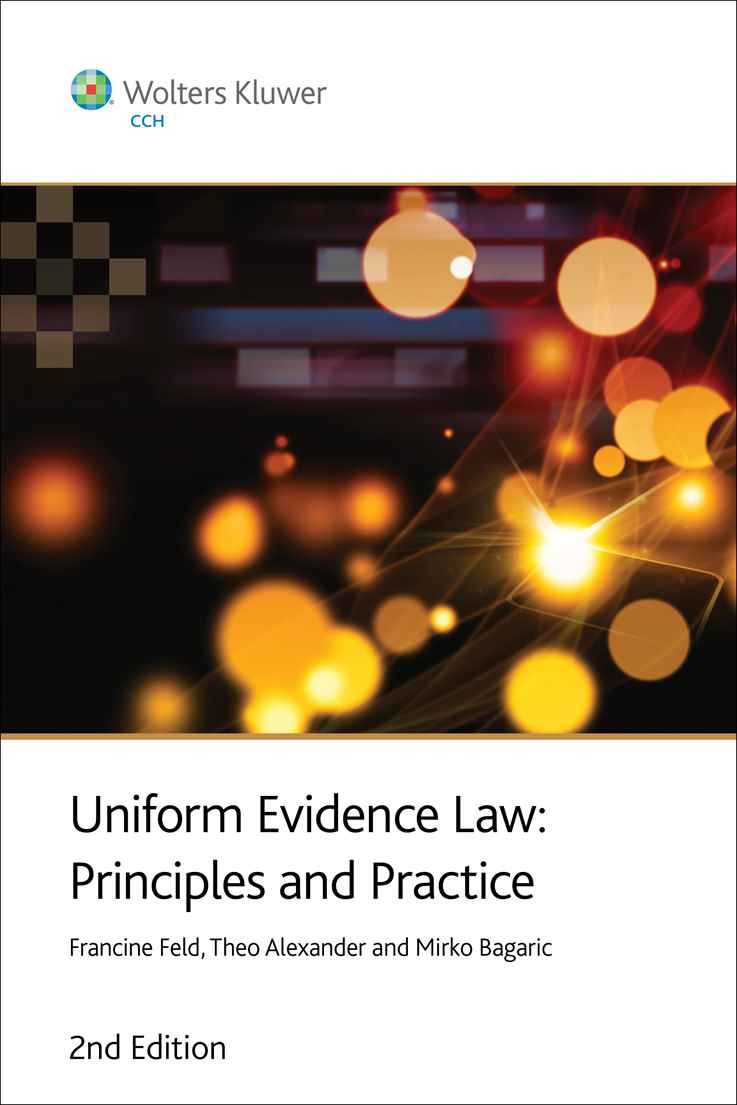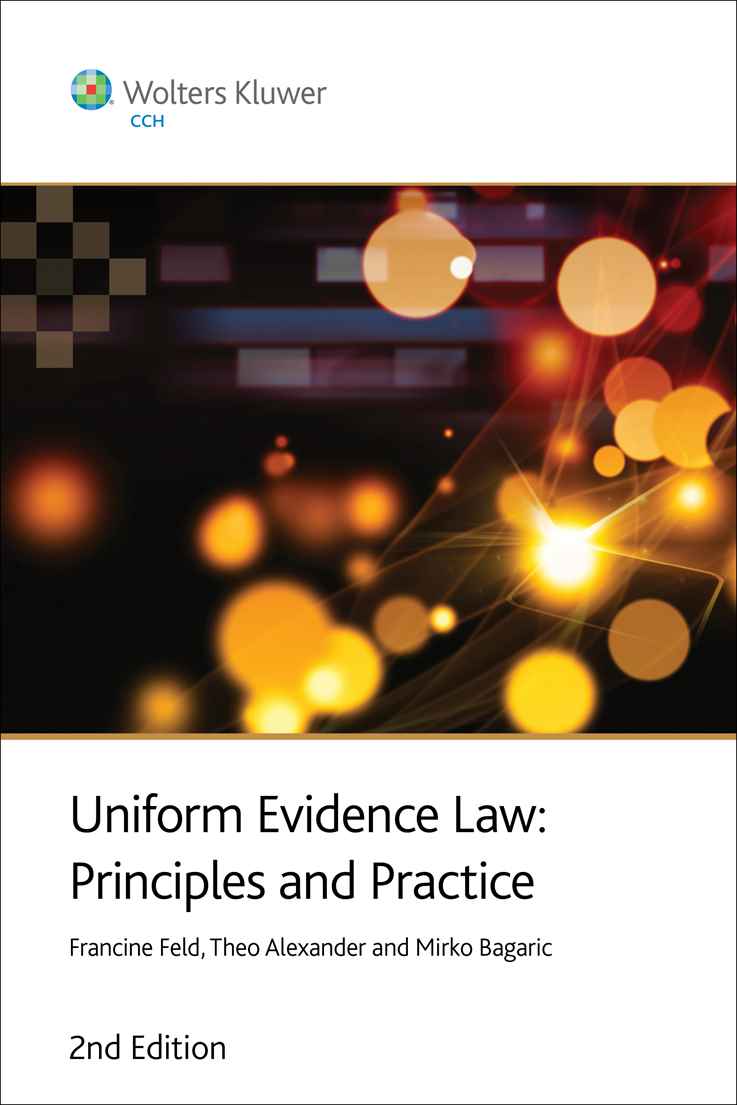CHAPTER 1: THE NATURE OF EVIDENCE LAW, ITS HISTORICAL FOUNDATIONS AND THE UNIFORM EVIDENCE ACTS
1.1 The nature of evidence law
1.1.1 Evidence law is procedural, not substantive
1.2 The objectives of evidence law — truth, discipline,
protection
1.2.1 Truth objective is important
1.2.2 Disciplinary objective — arguably flawed
1.2.3 Protective objective
1.2.4 Other objectives
1.3 Continued reform of evidence law
1.4 The historical foundations of evidence law
1.4.1 Early modes of trial
1.4.2 Reform to the modes of trial
1.4.3 Medieval juries
1.4.4 The advent of law reporting
1.4.5 The Victorian era
1.4.6 Evidence law in Twentieth Century Australia
1.5 The Uniform Evidence Acts
1.5.1 Jurisdictions applying the Act — the Cth, ACT, NI, NSW, Tas, Vic and the NT
1.5.2 Application of the Act to proceedings
1.5.3 Structure and interpretation of the UEA — consistency and inconsistency
1.6 The approach to resolving evidential issues under the Act
CHAPTER 2: OVERARCHING CONCEPTS: ROLE OF JUDGE AND JURY, BURDEN AND STANDARD OF PROOF AND TYPES OF EVIDENCE
2.1 Introduction
2.2 The nature of court proceedings and the roles of the judge and jury
2.2.1 Rules of evidence operate across courts and tribunals
2.2.2 Rules of evidence are stricter in criminal cases
2.2.3 Adversarial process
2.2.4 Order of proceedings and witnesses
2.2.5 Fact finder is either judge or juror
2.2.6 Voir dire — procedure for determining admissibility of evidence
2.3 Burden and standard of proof
2.3.1 Burden (or onus) of proof — civil and criminal proceedings
2.3.2 Standard of proof — civil proceedings — balance of probabilities
2.3.3 Standard of proof — criminal proceedings — beyond reasonable doubt
2.3.4 Standard of proof — admissibility of evidence — balance of probabilities
2.3.5 Standard of proof — evidential burden — prima facie case
2.4 Types of evidence
2.4.1 Verbal, documentary and physical evidence
2.4.2 Facts in issue
2.4.3 Direct and circumstantial evidence
2.4.4 Facts that do not need to be proved by evidence
CHAPTER 3: VERBAL EVIDENCE: WITNESSES — COMPETENCE, COMPELLABILITY AND EVIDENCE IN CHIEF AND CROSS-EXAMINATION
3.1 Introduction
3.2 Competence and compellability
3.2.1 Competence
3.2.2 Compellability
3.2.3 Minor exceptions to compellability
3.2.4 Major exception to compellability — family members of the accused
3.2.5 Major exception to compellability — the accused
3.2.6 The rationale for the right to remain silent
3.2.7 The extent of comment that can be made about the exercise of the right of silence
3.3 Examination in chief, cross-examination and reexamination
3.3.1 Calling witnesses
3.3.2 Examination in chief
3.3.3 Reviving memory
3.3.4 Unfavourable witnesses — cross-examining a party’s own witness
3.3.5 Cross-examination
3.3.6 Prior inconsistent statements
3.3.7 The need to inform witnesses of the intention to assert contrary facts
3.3.8 Re-examination
3.3.9 Re-opening cases
CHAPTER 4: DOCUMENTARY EVIDENCE AND OTHER EVIDENCE
4.1 Introduction
4.2 Documentary evidence
4.2.1 What is a document?
4.2.2 Proof of the contents of documents
4.2.3 Voluminous and complex documents
4.2.4 Authentication of documents
4.3 Other evidence
4.3.1 Introduction
4.3.2 The nature of "other evidence"
4.3.3 Other evidence outside the courtroom
4.3.4 Other evidence in the courtroom
4.4 Conclusion
CHAPTER 5: RELEVANCE
5.1 Introduction
5.2 Relevance and admissibility
5.3 Relevance — definition
5.4 Provisional relevance and inferences as to relevance
5.5 Conclusion
CHAPTER 6: THE HEARSAY RULE
6.1 Introduction
6.2 Hearsay and original evidence
6.3 Hearsay — the exclusionary rule
6.3.1 Previous representation made by a person
6.3.2 To prove a fact that was intended to be asserted
6.3.3 Implied hearsay and the intention of the maker of the representation
6.3.4 The intention requirement and express representations
6.3.5 Summary — identifying hearsay evidence
6.4 Exceptions to the rule against hearsay
6.4.1 Section 60 — evidence that is relevant for a non-hearsay purpose
6.4.2 First-hand hearsay
6.4.3 The first-hand hearsay exceptions — admissibility of first-hand hearsay
6.4.4 Unavailability of witnesses
6.4.5 First-hand hearsay in civil cases
6.4.6 First-hand hearsay in criminal cases
6.4.7 Criminal proceedings where maker is unavailable — s 65
6.4.8 First-hand hearsay in criminal cases where maker is available — s 66
6.4.9 First-hand contemporaneous statements about a person’s health etc — s 66A
6.4.10 Other exceptions to the hearsay rule
6.4.11 Business records — s 69
6.4.12 Tags and labels — s 70
6.4.13 Electronic communications — s 71
6.4.14 Aboriginal and Torres Strait Islander traditional laws and customs — s 72
6.4.15 Evidence as to reputation
6.4.16 Interlocutory proceedings — s 75
6.4.17 Evidence of domestic violence complainants — New South Wales
CHAPTER 7: OPINION EVIDENCE
7.1 Introduction
7.2 Rationale
7.3 Distinction between facts and opinions
7.4 Opinion rule — s 76
7.5 Exception: lay witness opinions — s 78
7.6 Exception: expert witness opinions — s 79
7.6.1 Specialised knowledge
7.6.2 Training study or experience
7.6.3 Wholly or substantially based on that knowledge
7.6.4 Common law basis rule
7.7Discretionary exclusion
7.8 Ultimate issue and common knowledge rules
7.8.1 Ultimate issue
7.8.2 Common knowledge
7.9 Evidence of previous judgments and convictions
CHAPTER 8: ADMISSIONS
8.1 Introduction
8.1.1 Admissions under the Uniform Evidence Act
8.2 What is an admission?
8.2.1 Against interest
8.2.2 Previous representations
8.3 Admissions are an exception to the hearsay and opinion rules
8.3.1 Admissions that are neither hearsay nor opinion
8.4 Exclusion of certain admissions
8.4.1 Exclusion of evidence of admissions that are not first-hand
8.4.2 Admissions not admissible as against third parties
8.4.3 Admissions influenced by violence and other conduct
8.4.4 Admissions by criminal defendants in the presence of investigators
8.4.5 Exclusion of records of oral questioning and mandatory electronic recording of admissions
8.5 Evidence of silence
8.5.1 Failure to mention a defence later relied on
8.5.2 Adverse inferences from silence in New South Wales — s 89A
8.6 Discretionary exclusion of admissions
8.6.1 The "unfairness" discretion — s 90
8.6.2 The discretion to exclude improperly obtained evidence and s 139
CHAPTER 9: TENDENCY AND COINCIDENCE EVIDENCE
9.1 Introduction
9.2 The admissibility of similar fact evidence — the various common law tests and overview of the UEA test
9.2.1 Makin — admissible if relevant test
9.2.2 Admissible if relevant otherwise than via propensity test
9.2.3 Probative value must outweigh prejudicial effect test
9.2.4 Another rational view test
9.2.5 Just to admit it despite prejudicial effect test
9.2.6 Overview of the test for similar fact evidence under the Act
9.2.7 Meaning of ‘‘significant probative value’’
9.2.8 Meaning of ‘‘prejudicial effect’’
9.2.9 ‘‘Substantially outweighs’’ — the balancing exercise in criminal cases
9.2.10 Application of the tests: divergence of approach
9.3 Evaluation of dangers associated with similar fact evidence
9.4 The importance of similar fact evidence
9.4.1 The conceptual basis for the relevance of similar fact evidence: propensity reasoning?
9.5 Reform suggestions
9.6 Similar fact evidence when it is not directly relevant to a fact in issue
9.6.1 Relationship evidence
9.6.2 Res gestae doctrine
9.7 Conclusion
CHAPTER 10: CREDIBILITY AND CHARACTER EVIDENCE
10.1 Introduction
10.2 Credibility of witnesses
10.2.1 The general rule — credibility evidence inadmissible
10.2.2 Credibility evidence of witnesses and people in relation to whom representations are admitted — when admissible
10.2.3 Special situation of prior convictions of accused
10.2.4 The finality rule and exceptions to the rule
10.2.5 Further exceptions: re-establishing credibility — re-examination and allegations of recent invention
10.3 Good character evidence by accused
10.4 Credibility evidence given by experts on credibility
10.5 Protection of complainants in sexual offence cases
CHAPTER 11: IDENTIFICATION EVIDENCE
11.1 Introduction
11.2 The dangers associated with identification evidence
11.3 The preference for identification parades
11.4 Picture identification evidence
11.5 Warnings to jury about the use of identification evidence
11.6 Voice identification
CHAPTER 12: UNRELIABLE EVIDENCE: CORROBORATION AND WARNINGS
12.1 Introduction
12.2 Corroboration
12.2.1 Corroboration and circumstantial evidence
12.2.2 Other categories of corroborative evidence
12.2.3 Accomplices and corroboration
12.3 Warnings — s 165
12.3.1 Examples
12.3.2 Other examples
12.4 Children and warnings — s 165A
12.5 Prosecutorial delay — s 165B
CHAPTER 13: PRIVILEGES
13.1 Introduction
13.1.1 Common law privileges and s 131A
13.1.2 Privilege claims
13.2 Client legal privilege
13.2.1 Rationale for the privilege
13.2.2 The scope of client legal privilege
13.2.3 Loss of client legal privilege
13.3 Privilege against self-incrimination
13.3.1 Rationale for the privilege
13.3.2 Scope of the privilege
13.3.3 Abrogation of the privilege
13.3.4 The accused as a witness
13.3.5 Corporations
13.4 Matters of state
13.4.1 Rationale
13.4.2 Scope
13.4.3 Class and content claims
13.4.4 Court inspection
13.5 Settlement negotiations
13.5.1 Rationale
13.5.2 Scope
13.5.3 Exceptions
13.6 Privileges in respect of confidential communications
13.6.1 Introduction
13.6.2 Professional confidential relationship privilege
13.6.3 Journalists’ privilege
13.6.4 Sexual assault communications privilege
13.6.5 Religious confessions
13.7 Judicial reasons privilege
CHAPTER 14: DISCRETIONS TO EXCLUDE EVIDENCE
14.1 Introduction
14.2 Granting leave — s 192
14.3 The relevant provisions — the discretions
14.3.1 Section 135 discretion
14.3.2 Section 136 discretion
14.3.3 Section 137 discretion
14.3.4 Meaning of "unfairly prejudicial"
14.4 Improperly and illegally obtained evidence
Case Table
Legislation Finding List
Index

